The Muses are those nine divine sisters who have been the wellspring of inspiration for artists, poets, and thinkers since time immemorial. In the realm of Greek mythology, these goddesses are the epitome of artistic and intellectual pursuits, each governing a specific domain of human creativity.
Muses Key Facts
Family tree
| Parents | Zeus and Mnemosyne |
| Partner(s) | None |
| Siblings | Each other |
| Offspring | None |
Names & Others
| Roman Name | Camenae |
| Other Names | N/A |
| The Goddess of | Art, Science, Literature |
| Symbols | Lyre, Scroll, Globe |
Name and Etymology
The term “Muse” originates from the Greek word “Mousai,” which is closely related to the term “mneomai,” meaning “to remember.” In Roman mythology, they are known as the Camenae. Various epithets and titles have been ascribed to them, each highlighting a different facet of their divine influence.
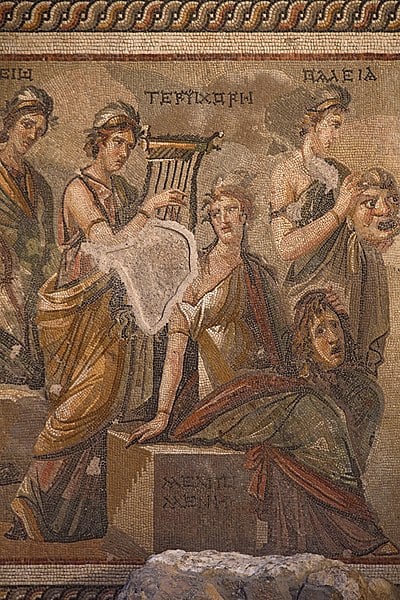
The Muses are often collectively referred to as “the Inspirers.” Each Muse has her own name that reflects her specific domain—Clio for history, Thalia for comedy, and so on. These names have etymological roots that often offer a glimpse into the essence of the domain they govern.
In the broader context of ancient languages, the names of the Muses have been adapted and adopted across various cultures and epochs. Whether you call them the Mousai or the Camenae, their essence remains the same: they are the eternal fountains of inspiration in their respective realms.
Muses Origins
The Muses are the daughters of Zeus, the king of the gods, and Mnemosyne, the goddess of memory. Born from this divine union, each Muse inherited traits that make her unique yet complementary to her sisters. They were born in Pieria, at the foot of Mount Olympus.
Their birth wasn’t accompanied by any extraordinary events; rather, they came into existence to fulfill a specific role in the cosmos—to inspire and guide human creativity. From their early days, they were tutored by Apollo, the god of music and arts, which shaped their divine responsibilities.
In Greek mythology, the Muses serve as personifications or Daemones (Spirits) of their respective domains. They are not merely abstract concepts but active participants in myths, often appearing to bestow their gifts upon mortals and gods alike. Their roles are deeply ingrained in the fabric of ancient stories, serving as both narrators and participants.
Muses Lovers and Relationships
Ah, love—a topic often explored in myths, yet surprisingly absent in the lives of the Muses. These goddesses are unique in that they don’t have famous love affairs or scandals to speak of. Their primary relationship is with their domains and those they inspire.

Relationship with Apollo
Apollo, the god of music, arts, and prophecy, is often considered the closest to the Muses. He serves as their mentor and companion, often accompanying them in various myths. While there’s no romantic involvement, the relationship is one of mutual respect and shared purpose.
For this reason Apollo was often called “Apollo Musagetes” (Apollo, leader of the Muses). Usually the Muses accompanied Apollo and the Graces on their walks and loved to sing and dance on soft feet on laurel leaves while Apollo played the lyre.
Relationship with Artists and Thinkers
The Muses have a unique kind of relationship with mortals—particularly artists, poets, and thinkers. They don’t engage in romantic liaisons but offer something perhaps more valuable: inspiration. This relationship is symbiotic; the Muses provide the creative spark, and in return, they are honored and celebrated through the works they inspire.
Muses Offspring
The Muses are unique in that they don’t have that many offspring in the traditional sense. Most of their “children,” so to speak, are the myriad works of art, literature, and science that have been created under their influence. These creations, both divine and mortal in nature, are testaments to their enduring impact on human civilization. However, there are some beings who have one of the Muses as a mother as well.
Divine Offspring: Masterpieces
In the realm of divine creations, one could argue that the masterpieces inspired by the Muses are their “offspring.” These are works of such extraordinary beauty or insight that they seem almost divine in origin.
Mortal Offspring: Human Creations
On the mortal plane, the Muses inspire countless works of art, literature, and scientific discovery. These “offspring” may not be divine, but they carry a spark of the Muses’ essence, serving as lasting tributes to their influence.
Depiction And Characteristics
When we envision the Muses, we often picture them as ethereal women, each holding an object that symbolizes her specific domain—a lyre for Euterpe, a scroll for Clio, and so on. These symbols serve as visual shorthand for their divine responsibilities.
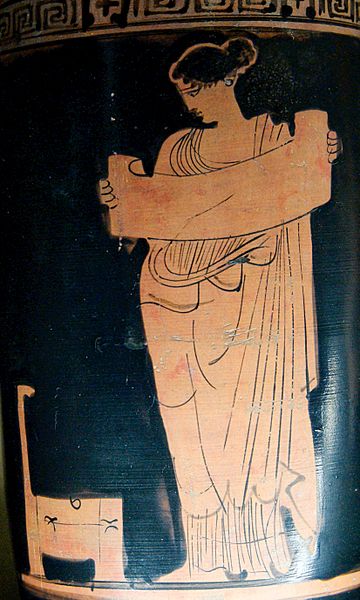
The Muses are usually depicted as young, beautiful women dressed in white robes, the universal color of purity in ancient Greece. They are often shown holding or surrounded by objects related to their domains, such as musical instruments, scrolls, or celestial globes.
Muses Personality and Powers
Personality-wise, the Muses are often portrayed as serene, wise, and benevolent. They are not capricious like some gods but focused on their divine mission to inspire and enlighten. Each Muse has her own temperament that aligns with her domain—Urania is contemplative, Clio is factual, and Thalia is playful, to name a few.
As goddesses of inspiration, the Muses possess the extraordinary ability to ignite the spark of creativity in mortals and gods alike. They don’t just inspire; they also guide, elevating the works they touch to the realm of the divine. Their powers are not overtly magical but subtly transformative, shaping culture and knowledge through the ages.
Muses Symbols
The Muses have different symbols that are emblematic of their domains. For instance, Calliope is often seen with a writing tablet, Urania with a globe and compass, and Clio with a lyre. These symbols serve as visual cues, helping us to instantly recognize which Muse we’re encountering in art or literature.
The Nine Muses
While they were all goddesses of the arts and science, each had a distinct area of responsibility.
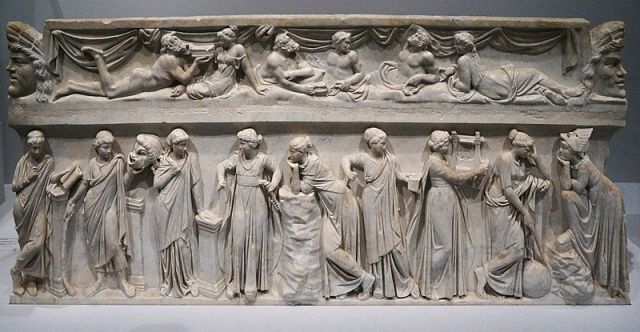
Calliope – the Muse of Epic Poetry
Calliope was the oldest and wisest of the 9 Muses. Calliope was so named because of her beautiful way of giving speeches. She was the most outstanding Muse of all and accompanied respected kings on their way.
Calliope was the favorite Muse of the Greek poet Homer, and many even consider Calliope to be the actual mother of Homer. Another child of Calliope is said to have been Orpheus, a famous musician and poet in ancient Greece.
In depictions, Calliope is seen young and beautiful, crowned with gold, holding a writing tablet or a volume of Homer’s Odyssey.
Clio – the Muse of Epic Poetry and History
Clio was the goddess of epic poetry and history and is also considered the inventor of the guitar.
Clio once fell madly in love with Pierus, king of Macedonia, and with him created the beautiful Hyacinth, lover of the Greek god Apollo.
Clio is often depicted dressed in purple with laurels in her hair, holding a cornet in one hand and a book in the other, the book with which Cleio wrote the story. At her feet lay the box of history.
Erato – the Muse of lyrical love poetry, hymns and wedding songs
Erato was the Muse and protector of love and is said to have been the one who actually invented the art of dancing.
Erato is usually depicted seated, wearing a rosary on her head and holding a guitar (or lyre) and a love bow in her hands. According to the ancient Greek writer Apollonius of Rhodes, Erato had the grace of Aphrodite and brought magic to unmarried girls.
Euterpe, the so-called “giver of joy,” was the Muse of music.
In ancient times, Euterpe was also associated with Lyric Poetry and sometimes with sports. Euterpe was usually depicted crowned with laurel, playing or holding a flute, with musical instruments and texts beside her.
When the Greek river Strymon once flowed with Euterpe, Euterpe gave birth to a son named Rhesus. Rhesus was a hero of Homer’s Iliad who was killed by the Greek hero Diomedes during the Trojan War.
Melpomene – the Muse of Tragedy
As her name suggests, Melpomene was the Muse of “molpe”, i.e. divine intonation. However, Melpomene was primarily considered the Muse of tragedy.
Melpomene was usually depicted alongside Dionysus, the god of wine. She was often depicted with a crown of vine leaves on her head, wearing a tragic mask and buskins, and holding a knife.
Polyhymnia – the Muse of sacred poetry
Polyhymnia (Polymnia) was the Muse of divine hymns, sacred poetry and pantomime. She was also famous for inventing the science of geometry.
Polyhymnia is often depicted as a very stern and thinking deity, with a wreath of daphne (laurel) in her hair, looking up to the sky and expressing herself with gestures while playing the lyre.
Thalia was the Greek Muse of comedy and pastoral poetry. She was the Muse who discovered comedy, geometry, architectural science and agriculture.
Terpischore – the Muse of Dancing
As her name suggests (“terpsis”:joy + “chorus”:dance), Terpsichore was the Muse of dance and dramatic chorus.
Most often Terpsichore was represented with a lyre, while other symbols of her were the triangle and the flute. Terpsichore was also considered the mother of the divinely singing Sirens, The Enchanting Voices of the Deep, who usually appeared as companions of the Muses in musical contests.
Thalia – the Muse of Comedy and Pastoral Poetry
Thalia had eyes from which love flowed. She was often depicted young and smiling, wearing an ivy wreath and holding a theatrical mask in her right hand and a staff in her left. Thalia’s main attribute was a shepherd’s crook.
Some mythologists claim that Thalia was also the Muse of vegetation, because of the origin of her name “thalo”, meaning “to flower”.
Urania – the Muse of astronomy and astrology
It is said that Urania was able to predict the future by the position of the stars. Urania was also the Muse of mathematics and a protector of the passion of love.
Urania was often depicted crowned with stars, holding a globe in her left hand and a compass in her right.
Myths about the Muses
The Muses are not just passive figures in the background of Greek mythology; they often take center stage in myths that explore the nature of artistic and intellectual inspiration. These myths serve as cautionary tales, moral lessons, and explorations of the divine influence on human creativity.
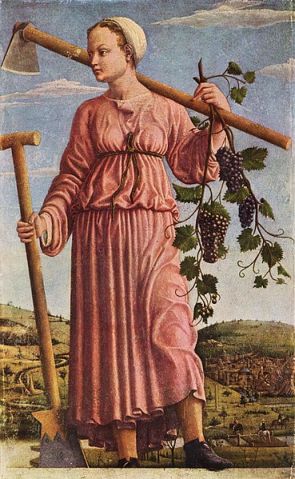
The Contest with the Sirens
In this captivating tale, the Muses engage in a musical duel with the Sirens, those infamous creatures known for luring sailors to their doom with their enchanting songs. The stakes were high, as the Sirens wagered their feathers against the Muses’ divine reputation. The Muses, with their celestial harmony, outperformed the Sirens, stripping them of their feathers to make victory crowns. This myth serves as a powerful allegory for the triumph of divine inspiration over mere seduction. It also establishes the Muses as the ultimate arbiters of artistic and musical excellence, capable of bestowing or stripping away fame.
The Punishment of Thamyris
Thamyris, a Thracian bard blessed with extraordinary musical talent, made the fatal mistake of challenging the Muses to a contest. Fueled by hubris, he claimed he could outperform them in song. The Muses, ever protective of their domain, accepted the challenge. When Thamyris was inevitably defeated, they didn’t stop at mere victory; they stripped him of his musical talent and left him blind, a stark reminder of the consequences of challenging the divine. This myth serves as a cautionary tale against the dangers of overconfidence and disrespect for the divine sources of artistic talent.
The Inspiration of Orpheus
Orpheus, the legendary musician and poet, was said to be a direct protégé of the Muses. His ability to move both mortals and gods with his lyre was a divine gift, a spark of inspiration that set him apart. When he descended into the Underworld to retrieve his beloved Eurydice, it was his Muse-inspired music that softened the hearts of Hades, the god of the underworld and Persephone, The Enigmatic Queen of the Underworld, granting him a chance to reclaim his lost love. Tragically, Orpheus failed to keep his promise not to look back at Eurydice until they reached the surface, losing her forever. This myth not only highlights the transformative power of Muse-inspired art but also explores the limitations of human nature, even when touched by the divine.
Each of these myths offers a different facet of the Muses’ roles in Greek mythology. They serve as both the inspiration for and the judges of artistic and intellectual endeavors, guiding these pursuits towards the divine while also guarding the boundaries between mortal and immortal realms. Through these myths, the Muses remind us of the awe-inspiring power of creativity, as well as the responsibilities and risks that come with it.
Muses In Ancient Greek Religion
The Muses were widely revered in ancient Greek religion, serving as the patrons of various forms of art and science.
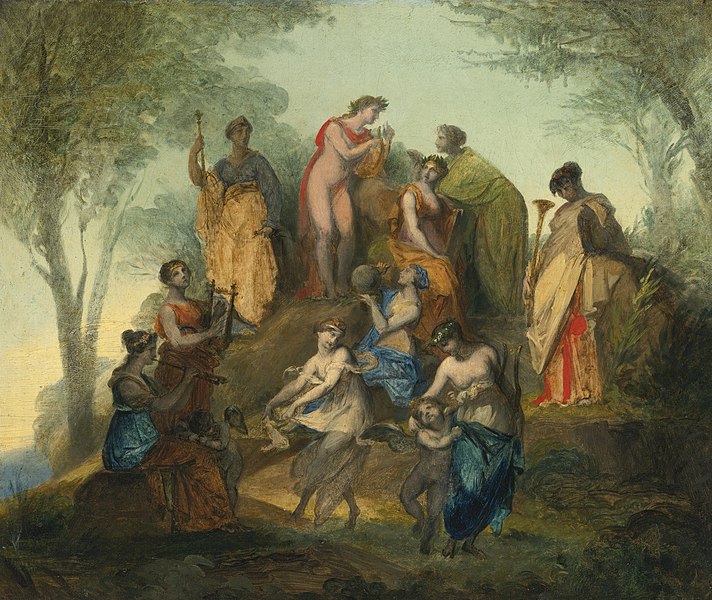
The most famous site dedicated to the Muses is Mount Helicon in Boeotia, home to the sacred spring of Hippocrene. Another significant site is the Oracle of Delphi, where the Muses were believed to have danced with Apollo. The Museum, originally a temple to the Muses, eventually gave its name to institutions dedicated to the arts and sciences.
Worship and Festivals
The Muses were honored in various festivals, the most notable being the Mouseia, held in their honor. Artists, poets, and scholars would gather to compete, their works serving as offerings to these divine patrons of the arts. The Muses were not just passive recipients of worship but active participants, their spirit invoked to guide and judge these artistic endeavors.
They have been a popular subject in art throughout history, often depicted in paintings, sculptures, and even modern media. In the Renaissance, they were a favorite subject, representing the epitome of artistic inspiration and intellectual pursuit.
Try The Muses Quiz
How well do you know Muses and their influence on art? Solve this puzzle and find out! And, don’t forget to try our other games!
Mentions in Ancient Texts
The Muses are frequently mentioned in ancient texts, serving both as characters and as symbols of artistic and intellectual pursuits. Homer invokes them in the “Iliad” and “Odyssey,” asking for their guidance in telling his epic tales. Hesiod’s “Theogony” also provides a detailed account of their birth and roles, describing them as “having one mind, their hearts set upon song and their spirit free from care.”
A quote from Hesiod’s “Theogony” encapsulates their essence: “He is happy whom the Muses love. For though a man has sorrow and grief in his newly-troubled soul and lives with dread because his heart is distressed, yet, when a singer, the servant of the Muses, chants the glorious deeds of men of old and the blessed gods who inhabit Olympus, at once he forgets his heaviness and remembers not his sorrows at all.”
Frequently Asked Questions
The Muses are the goddesses of art, science, and literature, serving as the source of inspiration for these domains.
Yes, they are the daughters of Zeus and Mnemosyne.
Their symbols vary but often include musical instruments, scrolls, and celestial globes.
Yes, they appear in myths involving contests of skill. Examples are their victory over the Sireens and the punishment of Thamyris.
Absolutely, they were revered as the patrons of various forms of art and science. Several festivals and temples were dedicated to them.
They are often shown as young, beautiful women holding objects related to their specific domains.
Featured Image Credit: Hendrick van Balen the Elder, Joos de Momper, Jan Brueghel the Elder, Public domain, via Wikimedia Commons
